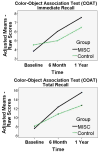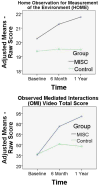A year-long caregiver training program improves cognition in preschool Ugandan children with human immunodeficiency virus
- PMID: 23958115
- PMCID: PMC3812379
- DOI: 10.1016/j.jpeds.2013.06.055
A year-long caregiver training program improves cognition in preschool Ugandan children with human immunodeficiency virus
Abstract
Objective: To evaluate mediational intervention for sensitizing caregivers (MISC). MISC biweekly caregiver training significantly enhanced child development compared with biweekly training on health and nutrition (active control) and to evaluate whether MISC training improved the emotional well-being of the caregivers compared with controls.
Study design: Sixty of 120 rural Ugandan preschool child/caregiver dyads with HIV were assigned by randomized clusters to biweekly MISC training, alternating between home and clinic for 1 year. Control dyads received a health and nutrition curriculum. Children were evaluated at baseline, 6 months, and 1 year with the Mullen Early Learning Scales and the Color-Object Association Test for memory. Caldwell Home Observation for Measurement of the Environment and videotaped child/caregiver MISC interactions also were evaluated. Caregivers were evaluated for depression and anxiety with the Hopkins Symptoms Checklist.
Results: Between-group repeated-measures ANCOVA comparisons were made with age, sex, CD4 levels, viral load, material socioeconomic status, physical development, and highly active anti-retroviral therapy treatment status as covariates. The children given MISC had significantly greater gains compared with controls on the Mullen Visual Reception scale (visual-spatial memory) and on Color-Object Association Test memory. MISC caregivers significantly improved on Caldwell Home Observation for Measurement of the Environment scale and total frequency of MISC videotaped interactions. MISC caregivers also were less depressed. Mortality was less for children given MISC compared with controls during the training year.
Conclusions: MISC was effective in teaching Ugandan caregivers to enhance their children's cognitive development through practical and sustainable techniques applied during daily interactions in the home.
Trial registration: ClinicalTrials.gov NCT00889395.
Keywords: CAI; CBCL; COAT; Child Behavior Checklist; Childhealth Advocacy International; Color-Object Association Test; HAART; HOME; HSCL-25; Highly active anti-retroviral therapy; Home observation for measurement of the environment; Hopkins Symptoms Checklist 25-item; MELS; MISC; MSU; Mediational intervention for sensitizing caregivers; Michigan State University; Mullen Early Learning Scales; OMI; Observing mediational interactions; RM-ANCOVA; Repeated-measure ANCOVA; UCOBAC; Uganda Community Based Organization for Child Welfare.
Copyright © 2013 Mosby, Inc. All rights reserved.
Conflict of interest statement
The authors declare no conflicts of interest.
Figures




References
-
- Armstrong F, Willen E, Surgen K. Handbook of Pediatric Psychology. 3. 2003. HIV/AIDS in Children and Adolescents; pp. 359–74.
-
- Bose S. An examination of adaptive functioning in HIV infected children: Exploring the relationships with HIV disease, neurocognitive functioning, and psychosocial characteristics. ProQuest Information & Learning. 1997 Jul;58(409) AAM9719709. 1997; Dissertation Abstracts International: Section B: The Sciences and Engineering.
-
- Klein P, Rye H. Interaction-Oriented Early Intervention in Ethiopia: the MISC Approach. Infants and Young Children. 2004;17:340–54.
-
- Klein PS, editor. Early Intervention: cross-cultural experiences with a mediational approach. New York, NY: Garland Press; 1996.
Publication types
MeSH terms
Associated data
Grants and funding
LinkOut - more resources
Full Text Sources
Other Literature Sources
Medical
Research Materials

